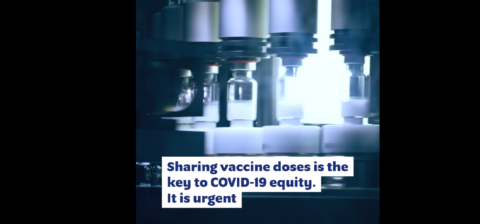We have a realistic hope of producing 11 billion COVID-19 vaccines by the end of 2021 to vaccinate the world’s whole adult population. With increased dose sharing and urgent measures to ensure vaccine equity through COVAX and other bilateral agreements, we would like to see many more vaccines reaching all four corners of the world in the second half of 2021.
So that every dose received is administered quickly and effectively, country readiness is a key pillar of the global strategy for COVID-19 vaccination. Rolling out mass vaccination campaigns presents logistical challenges for any country. Low- and middle-income countries (LMIC) face particular challenges. Many LMICs have well established childhood vaccine delivery, but not all countries are as well equipped to target large numbers of adults and reach them several times, as most of the COVID-19 vaccines require two doses.
Country readiness to absorb COVID-19 vaccines deliveries is vital
National COVID-19 vaccination programs require detailed planning and adequate resourcing. As vaccine deliveries ramp up in LMICs, with deliveries increasing 3-6 times in the 4th quarter from current levels, countries must be ready to roll out vaccination programs as soon as doses are delivered. According to WHO AFRO, 49 African countries have been recently notified of the allocations they will receive[1]. Each country has an absorption capability that will dictate how they can best use the large COVID-19 vaccine deliveries expected in the coming weeks. Governments should use this time to prepare for the roll-out, conduct reviews and focus on:
- Developing national vaccination plans
- Establishing regulatory vaccine approval and vaccine safety systems
- Building vaccine distribution infrastructure on the ground, including cold chain capacities
- Training of staff involved in deployment and delivery of vaccines
- Strengthening data collection, reporting and tracking systems
- Addressing hesitancy issues by planning public health campaigns to generate trust and demand for COVID-19 vaccines.
Vaccine deliveries scale-up
Every country must overcome distribution challenges but LMICs will come under increasing pressure over the coming months to administer all the doses that have been allocated to them and to limit the risk of dose wastage. COVAX aims to deliver 1.9 billion doses to 91 countries in Q4 2021, including 520 million COVID-19 vaccine doses to Africa in 2021, and nearly 850 million by the end of the first quarter of 2022. Most of these doses will be delivered from September 2021 onwards.
As vaccine deliveries ramp up, distribution bottlenecks could worsen and risk more doses becoming expired. In the same way that vaccine manufacture has been accelerated, more can be done to provide operational funding and technical support to bolster LMIC programs. To help prepare LMICs for this acceleration, an additional US$ 775 million of funding for COVAX vaccine delivery has recently been approved[2] in complement of delivery funding from USAID and the Asian Development Bank. But the clock is ticking and serious gaps in country readiness remain.
Logistical challenge of multiple COVID-19 vaccines
Today, we are lucky to have several approved COVID-19 vaccines, but this adds complexity as well. Countries will receive supply of different vaccine products, from Pfizer/BioNTech, Johnson & Johnson, AstraZeneca/SII, Moderna, Novavax, Sinovac, and Sinopharm, constituting an additional complexity for healthcare workers and programs. Healthcare professionals need product specific training and guidance, delivery strategies need to fit product specificities, and each vaccine requires different cold chain capacities, as well as track and trace processes.
Confidence in COVID-19 vaccines: Winning over hearts and minds
Additionally, factors leading to delays include hesitancy among the population to get the vaccine. Misinformation campaigns present another threat that could undermine efforts to get the pandemic under control.
To build confidence and understanding, governments, community-based organizations, healthcare providers and vaccine manufacturers need to work together. Health campaigns have a role to play in ensuring quality information reaches people to generate public confidence, trust and demand for COVID-19 vaccines. Vaccine hesitancy has been a concern of our industry for many years and we take our efforts to address vaccine hesitancy just as seriously as we do our R&D and manufacturing work. Our industry embraces the highest regulatory standards and works with health authorities to strengthen pharmacovigilance systems, develop the capabilities to monitor and investigate potential adverse events quickly, and to communicate and address public concerns proactively.
Success relies on whole health system approaches
According to Marian Wentworth, President and Chief Executive Officer of Management Sciences for Health (MSH), an organization that helps build resilient and sustainable health systems, with extensive experience in some of the globe’s most challenging environments, many vaccine distribution challenges could be overcome with technologies that facilitate cold supply chain monitoring, patient records and collection of information, and last mile delivery logistics[3]. Innovative technology and collaborative partnerships will be critical to build resilient health systems that are able to deliver immunization services across the life span, both during and outside of pandemics.
In April 2021, WHO warned that COVID-19 continues to disrupt essential health services in 90% of countries. The COVID-19 pandemic poses serious challenges to many countries, including disrupting routine immunization programs. Twenty-three million children missed out on basic vaccines through routine immunization services in 2020 – 3.7 million more than in 2019 – according to data published recently by WHO and UNICEF.
We all need to work together to help countries strengthen their COVID-19 vaccine rollout, and get routine immunization programs and other essential health services back on track.
[1] https://www.afro.who.int/news/africas-covid-19-surge-tops-second-wave-peak-vaccine-deliveries-pick
[2] https://www.gavi.org/news/media-room/gavi-board-strengthens-commitment-reaching-most-vulnerable-through-routine
[3] https://nextbillion.net/covid19-vaccine-distribution-partnerships-technology-supply-chains/













